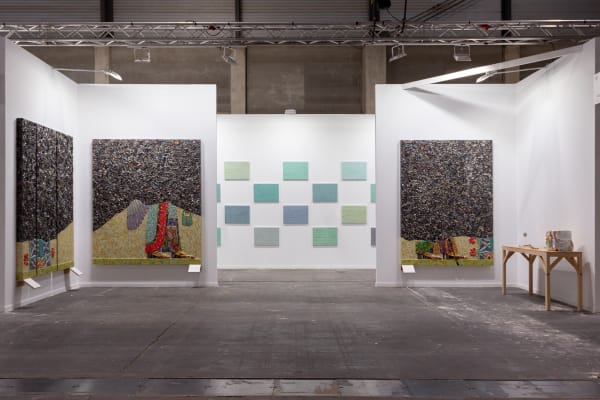Booth 7A01
We are pleased to present the works of our artists Albano Hernandez and Michael Rakowitz at our first participation in the ARCOmadrid fair.
Albano Hérnandez (b.1988) Ávila, Spain, lives and works in Cambridge, UK. He graduated from the Royal College of Art in 2022 (MA Painting) and holds a Bachelor of Fine Arts from the Complutense University of Madrid, UCM.
Winner of the Hine painting prize in 2022, Albano Hernandez has developed his ‘meta-painting’ process over the last two years. Growing up in Ávila, a region of Spain where meat consumption and industry plays a significant role in the culture and economy, led Albano to focus on the aesthetics that meat generates as a commodity. Manipulation of materiality interest the artist and thus Albano employs an industrial meat-slicer to fragment his own brushstrokes in this body of work, sometimes then vacuum-packing his paintings to create works reminiscent of packeted supermarket meat. Waste also plays an equally significant role in Albano’s practice, with the artist initially repurposing old studio materials in his paintings to create a circular economy of both physical production and conceptual dialogues between present and past creations. By incorporating waste from his everyday life, Albano draws attention to issues of sustainability and environmentally conscious production as well as to the dichotomy between the values we place on ‘waste’ vs that of ‘fine art.’
American artist Michael Rakowitz (b. 1973) grew up in an Iraqi family in New York, and lives and works in Chicago. Across two decades, his practice has focused on highlighting the invisibility of Iraqis beyond images of conflict, either through food, archaeological artifacts or other narratives.
Michael Rakowitz’s “The invisible enemy should not exist” is an ongoing series that he began in 2007. The goal: to recreate the missing and destroyed artifacts taken from the National Museum of Iraq, more than 7,000 in total—a cultural pillaging that occurred in the early 2000’s during the Iraq War and its wake. Then, in 2015, Rakowitz extended the series to include the “reappearance” of the relief panels from Kalhu (Nimrud), room by room. To bring these artifacts and panels back to something of its original colorful form, Rakowitz uses a papier-mâché technique with Middle Eastern product packaging and Arabic-English newspapers. This not only references back to prior and seminal series of his, but it also speaks to the very birth of this series itself—the idea of consumption by the West of this region’s riches and history, paired with the simultaneous discarding of the worth and identity of its people, their “wrappers”, their context.


